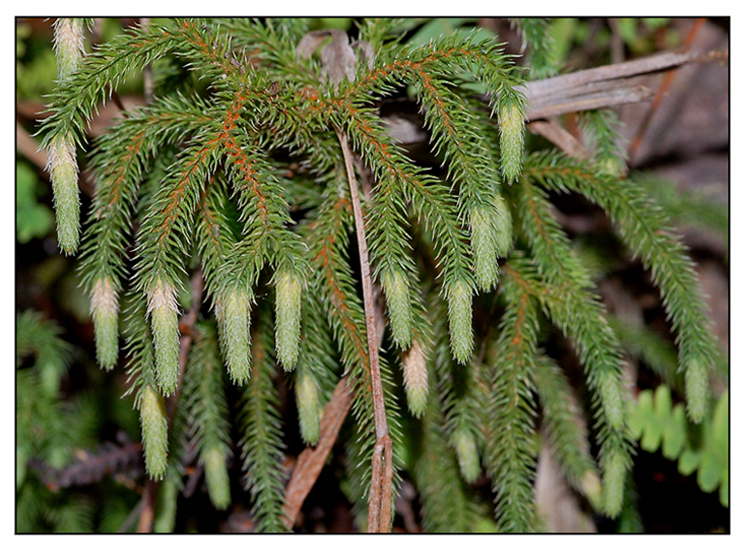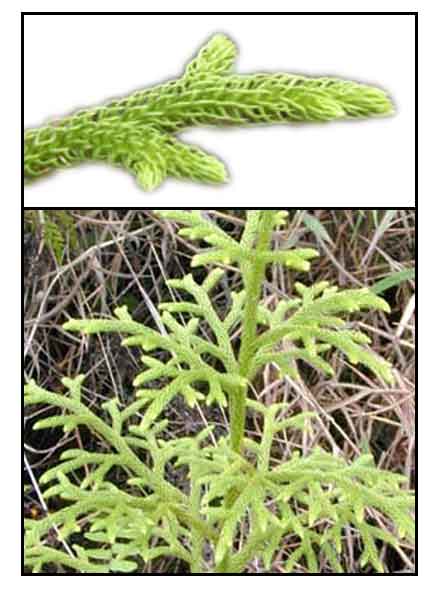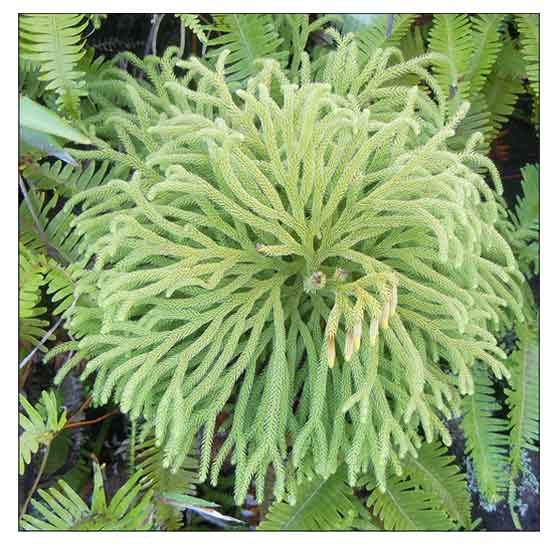 Gen info Gen info
- Lycopodiella is a genus in the family Lycopodiaceae, members of which are commonly called bog club mosses, referring to their wetland habitat.
- The genus was often incorporated within the genus Lycopodium, but was segregated in 1964. Depending on circumscription, the genus has 15-40 species.
(13)
Botany
Lamon-babae is a prostrate plant, with stout and creeping stems,
30 to 100 centimeters long, and with small bristly leaves throughout. Primary branches are rigidly erect, 20 to 60 centimeters long,
much branched in the upper portion; the lower branches are divided and short,
spreading or ascending, pendulous towards the tips. Leaves are inserted all around the stems and branches, crowded, narrowly linear-subulate, 2 to 3 millimeters long. Spikes (cone-like fruiting bodies) are numerous, solitary,
and sessile on the tips of the branchlets, 5 to 15 millimeters long.
 Distribution Distribution
- Native to the Philippines.
-
Widely distributed; abundant
at medium and high altitudes, rare at low altitudes.
- Found throughout the warmer countries of the Old World.
- A perennial or subshrub growing primarily in the wet tropical biome.
Constituents
- Study yielded a new triterpenoid (16-oxo-21-episerratriol) and a flavonoid (cernoside) together with known alkaloids lycocernuine and cernuine, triterpenoids, aonocerin diacetate, serratenediol diacetate, serratriol triacetate and 21-episerratriol triacetate.
- Study isolated three new serratene-type triterpenoids (1-3) and a new hydroxy unsaturated fatty acid (13) together with nine known compounds (4-12). (see study below) (12)
- Study of whole plant isolated three new compounds, namely: lycocernuaside E (1), lycernuic ketone F (2), and lycernuic B (3) and 12 known ones (4-15). (see study below) (16)
- Study of Lycopodiella cernua isolated three new serratene-type triterpenoids (1-3) and a new hydroxy unsaturated fatty acid (13) together with nine known compounds (4-12).
(see study below) (19)
- Study of whole plant isolated two serratane triterpenoids, 3β, 14α, 15α, 21β-tetrahydroxyserrat-15-(3'-methoxyl-4'-hydroxybenzoate) (1) and 16-oxoserrat-14-en-3β, 21α-diol (2). (see study below) (19)
- Study of aerial parts isolated four metabolites, serrat-14-en-3β,21β-diol (1), serrat-14-en-3β,21α-diol (2), 3β,21β-dihydroxyserrat-14-en-21-yl acetate (3), and nonacosanol (4). (20)
- Study isolated a new pentacyclic Lycopodium alkaloid named isopalhinine A, (1)
which possesses a sterically congested architecture built with a tricyclo[4.3.1.03,7]decane (isotwistane) moiety and a 1-azabicyclo[4.3.1]decane moiety, and palhinines B (2) and C (3). (22)
Properties
- Sweet tasting, cooling natured.
- Antirheumatic, antitussive, diuretic.
- Studies have suggested anti-influennza, antifungal, antibacterial, anti-H. pylori, cholinesterase inhibitory, nootropic, anti-amnesic, nootropic, anti-inflammatory, anticancer, anti-silicosis properties.
Parts
utilized
· Whole plant.
· Collect the plants throughout the year.
· Rinse, cut into pieces and sun-dry.
· Compress before storing.
Uses
Folkloric
• Decoction of 15-30 gms of
dried material used for acute hepatitis, reddening and swelling in the
eyes, costochondritis, chronic cough.
• Decoction used as a lotion in beriberi.
• Decoction used for coughs and uneasiness of the chest.
• Embrocation of its ashes in vinegar used for skin eruptions.
 • Decoction of plant used as diuretic; also for rheumatism, diarrhea, dysentery and tenesmus. • Decoction of plant used as diuretic; also for rheumatism, diarrhea, dysentery and tenesmus.
• Used medicinally throughout Malaysia for external application.
• In Fiji, traditional
use as an antifungal.
• In the Antilles, powder is dusted on irritated parts of children from contact of urine.
• Powder used against diarrhea and dysentery.
• In French Guiana,
used for leg pains, spider bites, fever, and in herbal baths
• In French Polynesia,
used in treatment for hay fever.
• In India,
spores are applied as antiseptic in wounds and injuries. Also, fresh plant infusion used for intestinal infection. Also, for rickets in children.
• In Kerala,
for chicken pox drink a lukewarm water concoction of 5 gm of Oryza meyeriana seeds ground to a paste with 5 gm of L. cernuum, a black ant's head (Monorium dichroum) and 100 mg Jumboldtia unijuga (root gall).
Others
• Ornamental / Crafts: In the Philippines, in much demand among florists, especially around All Saints' Day, when it is used for making wreaths, baskets and other floral decorations. In India, used as an ornament. (•) In Indonesia and Columbia, used for stuffing cushions as a kapok substitute. (14)
• Gunpowder: Spores mixed with gunpowder to increase efficiency of gunpowder and reduce the decibel of explosion.
• Rituals / Superstition: Leaves used for sacred rituals. Women do not use the plant during their menstrual periods. In some places, plants are harvested with utmost respect for cultural traditions. Some believe improper use can put the user in great danger. (11)
• Agro: In Malaysia, used as a cover crop in rubber plantations, especially on degraded soils.
• Repellent: in Micronesia, used as a cockroach repellent. (14)
Studies
• Antimicrobial / Anti-Helicobacter
pylori: In vitro anti-Helicobacter pylori activity of
Lycopodium cernuum (Linn) Pic. Serm: All fractions of LC extracts demonstrated
antimicrobial activity suggesting the plant contains compounds with
therapeutic activity. Pharmacologically active compounds such as alkaloids
and serratene triterpenes have been found in L cernuum which may be
responsible for its antimicrobial effect. 5 fractions from the hexane
fraction (100% hexane) yielded the highest activity. Study suggests
the plant is a potential source of an antibacterial agent for the treatment
of H. pylori. (1)
• Antifungal: Fractionation
of ethanol extract of L cernuum for Candida albicans secreted aspartic
proteases (SAP) inhibition resulted in six new and four known serratene
triterpenes and an apigenin-glucopyranoside. Two compounds, lycernuic
acid C and and apigenin-4'-O(2',6' '-di-O-p-coumaroyl)-beta-D-glycopyranoside,
showed inhibitory effects against C albicans secreted aspartic proteases. (2)
• Cholinesterase Inhibitors: Acetylcholinesterase (AChE) inhibitors increase the availability of acetylcholine in the central cholinergic synapses and are promising drugs for the treatment of Alzheimer's disease. Study showed the water fraction of a methanolic extract of Lycopodiella cernua significantly inhibited AChE in vitro. Fractionation isolated a new lignan glycoside, lycocernuaside A, together with 15 known compounds. Compound 7 exhibited potent AChE inhibitory activity. Compound 15 showed potent inhibitory activity against BChE and BACE1 while compounds 4 and 7 showed mixed- and competitive-type AChE inhibition. (9)
• Anti-Amnesic / Nootropic: Study evaluated the alkaloid fraction of a methanol extract for in vitro acetylcholinesterase (AChE) inhibitory activity in cognition-relevant brain areas of mice. In the in vivo study, the cognitive enhancing effect on amnesic mice induced by scopolamine was investigated by assessment of passive avoidance and a water maze test. Results showed anticholinesterase activity with significant reversal of cognitive impairment in mice. (10)
• Acetylcholinesterase Inhibitory Activity: Study isolated three new serratene-type triterpenoids (1-3) and a new hydroxy unsaturated fatty acid (13) together with nine known compounds (4-12). Compound 13 showed the most potent inhibitory activity against AChE with IC50 value of 0.22µm. (12)
• Anti-Inflammatory / Antioxidant / Aerial and Ground Parts: Study evaluated crude methanolic extract of aerial and ground parts for antioxidant and anti-inflammatory activities. Phenolic contents were 33.04 and 4.91mg GAE/g, flavonoids contents 11.46 and 5.82 µg QE/g for aerial and ground parts, respectively. DPPH radical scavenging was also relatively low at 19.13% and 12.21%, respectively. COX-2 inhibition activity was 74.78% for ground parts. A COX2:COX1 ration of 1.29 of aerial parts suggested selectivity for COX2. Extracts were nontoxic against HEKn normal cells lines and A549 cancer cell lines. Results suggested nontoxicity and antioxidant and anti-inflammatory activities. (15)
• Anti-Inflammatory / Anticancer / Whole Plant: Study of whole plant isolated three new compounds, namely: lycocernuaside E (1), lycernuic ketone F (2), and lycernuic B (3) and 12 known ones (4-15). Compounds 5, 12, and 13 exhibited NO inhibitory effects in LPS-stimulated BV2 cells, with IC50s of 21.2, 28.5, and 21.9 µM, respectively. Cytotoxic activity of isolated compounds against MCF7 (breast carcinoma), HepG2 (hepatocarcinoma), and SK-Mel2 (melanoma) cancer cell lines were also reported. (16)
• Acetylcholinesterase Inhibitory / Anticancer / Lycopodium Alkaloids / Whole Plant: Bioactivity-guided isolated of alkaloidal extract of whole plant led to isolated of six lycopodium alkaloids. Compound 5 showed most activity against AChE with IC50 of 1.9 µM, while the new compound 1 showed weak inhibitory activity wit IC50 of 102 µM. Compound 1 and 3 inhibited A549 (lung carcinoma epithelial cells) cell line with IC50 of 12.6 and 18.4 µM, respectively. (17)
• Cholinesterase and ß-Secretase 1 Inhibiting Compounds: Study of Lycopodiella cernua isolated three new serratene-type triterpenoids (1-3) and a new hydroxy unsaturated fatty acid (13) together with nine known compounds (4-12).
Compound 13 showed most potent inhibitory activity against acetylcholinesterase (AChE) with IC50 0.22 µM. Compound 5 showed most potent activity against butyrylcholinesterase (BChE) inhibitory actiivity with IC50 0.4 µM. Compound 2 showed most potent BACE-1 inhibitory activity with IC50 0.23 µM. AChE inhibition by 4, 5, and 13 were mixed; BChE inhibition by 5 was competitive; 2 and 6 were mixed. (18)
• Serratane Triterpenoids / Anti-Influenza A Virus Activity / Whole Plant : Study of whole plant isolated two serratane triterpenoids, 3β, 14α, 15α, 21β-tetrahydroxyserrat-15-(3'-methoxyl-4'-hydroxybenzoate) (1) and 16-oxoserrat-14-en-3β, 21α-diol (2). The two compounds were evaluated for anti-IAV (influenza A virus) activity against A/WSN/33 (H1N1). Preliminary antiviral screening showed compounds 1 and 2 exhibited 9% and 36% inhibition activity at 50 µmol/L, respectively. (19)
• Anti-Silicosis: Study evaluated the anti-silicosis action of Shenjincao injection prepared from Palhinhaea cernua for prophylaxis and treatment of experimental silicosis in wistar rats. Silicosis was injected intra-tracheally using quartz dust. Silica-exposed rats were injected intra-peritonerally three times a week with shenjincao for 5-11 weeks. Results showed shenjincao injection is efficacious against experimental silicosis, both prophylactically and for treatment of disease. (21)
Availability
- Wild-crafted.
- Plants and powdered formulations in the cybermarket.
|


